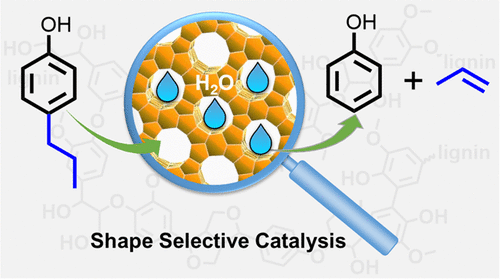当前位置:
X-MOL 学术
›
ACS Catal.
›
论文详情
Our official English website, www.x-mol.net, welcomes your
feedback! (Note: you will need to create a separate account there.)
Propylphenol to Phenol and Propylene over Acidic Zeolites: Role of Shape Selectivity and Presence of Steam
ACS Catalysis ( IF 11.3 ) Pub Date : 2018-07-30 00:00:00 , DOI: 10.1021/acscatal.8b01564
Yuhe Liao 1 , Ruyi Zhong 1 , Ekaterina Makshina 1 , Martin d’Halluin 1 , Yannick van Limbergen 1 , Danny Verboekend 1 , Bert F. Sels 1
ACS Catalysis ( IF 11.3 ) Pub Date : 2018-07-30 00:00:00 , DOI: 10.1021/acscatal.8b01564
Yuhe Liao 1 , Ruyi Zhong 1 , Ekaterina Makshina 1 , Martin d’Halluin 1 , Yannick van Limbergen 1 , Danny Verboekend 1 , Bert F. Sels 1
Affiliation

|
This contribution studies the steam-assisted dealkylation of 4-n-propylphenol (4-n-PP), one of the major products derived from lignin, into phenol and propylene over several micro- and mesoporous acidic aluminosilicates in gas phase. A series of acidic zeolites with different topology (e.g., FER, TON, MFI, BEA, and FAU) are studied, of which ZSM-5 outperforms the others. The catalytic results, including zeolite topology and water stability effects, are rationalized in terms of thermodynamics and kinetics. A reaction mechanism is proposed by (i) analyzing products distribution under varying temperature and contact time conditions, (ii) investigating the dealkylation of different regio- and geometric isomers of propylphenol, and (iii) studying the reverse alkylation of phenol and propylene. The mechanism accords to the classic carbenium chemistry including isomerization, disproportionation, transalkylation, and dealkylation, as the most important reactions. The exceptional selectivity of ZSM-5 is attributed to a pore confinement, avoiding disproportionation/transalkylation as a result of a transition state shape selectivity. The presence of water maintains a surprisingly stable catalysis, especially for ZSM-5 with low acid density. The working hypothesis of this stabilization is that water precludes diphenyl ether(s) formation in the pores by reducing the lifetime of the phenolics at the active site due to the high heat of adsorption of water on H-ZSM-5, besides counteracting the equilibrium of the phenolics condensation reaction. The water effect is unique for the combination of (alkyl)phenols and ZSM-5.
中文翻译:

酸性沸石上的丙基苯酚制苯酚和丙烯:形状选择性和蒸汽存在的作用
该贡献研究了在数种微孔和中孔酸性硅铝酸盐上在气相下将木质素衍生的主要产物之一的4-正丙基苯酚(4- n- PP)进行蒸汽辅助脱烷基化为苯酚和丙烯的过程。研究了一系列具有不同拓扑的酸性沸石(例如FER,TON,MFI,BEA和FAU),其中ZSM-5优于其他沸石。催化结果,包括沸石的拓扑结构和水稳定性的影响,在热力学和动力学方面是合理的。通过(i)在变化的温度和接触时间条件下分析产物的分布,提出了一种反应机理,(ii)研究丙基苯酚的不同区域和几何异构体的脱烷基,和(iii)研究苯酚和丙烯的反向烷基化。该机理符合经典的碳鎓化学,其中最重要的反应包括异构化,歧化,烷基转移和脱烷基。ZSM-5的出色选择性归因于孔限制,避免了过渡态形状选择性导致歧化/烷基转移。水的存在保持了出乎意料的稳定催化作用,尤其是对于酸密度低的ZSM-5。这种稳定作用的工作假设是,由于水在H-ZSM-5上的高吸附热,水会通过减少酚类化合物在活性部位的寿命而减少孔隙中二苯醚的形成,并抵消了平衡。酚的缩合反应。
更新日期:2018-07-30
中文翻译:

酸性沸石上的丙基苯酚制苯酚和丙烯:形状选择性和蒸汽存在的作用
该贡献研究了在数种微孔和中孔酸性硅铝酸盐上在气相下将木质素衍生的主要产物之一的4-正丙基苯酚(4- n- PP)进行蒸汽辅助脱烷基化为苯酚和丙烯的过程。研究了一系列具有不同拓扑的酸性沸石(例如FER,TON,MFI,BEA和FAU),其中ZSM-5优于其他沸石。催化结果,包括沸石的拓扑结构和水稳定性的影响,在热力学和动力学方面是合理的。通过(i)在变化的温度和接触时间条件下分析产物的分布,提出了一种反应机理,(ii)研究丙基苯酚的不同区域和几何异构体的脱烷基,和(iii)研究苯酚和丙烯的反向烷基化。该机理符合经典的碳鎓化学,其中最重要的反应包括异构化,歧化,烷基转移和脱烷基。ZSM-5的出色选择性归因于孔限制,避免了过渡态形状选择性导致歧化/烷基转移。水的存在保持了出乎意料的稳定催化作用,尤其是对于酸密度低的ZSM-5。这种稳定作用的工作假设是,由于水在H-ZSM-5上的高吸附热,水会通过减少酚类化合物在活性部位的寿命而减少孔隙中二苯醚的形成,并抵消了平衡。酚的缩合反应。

































 京公网安备 11010802027423号
京公网安备 11010802027423号